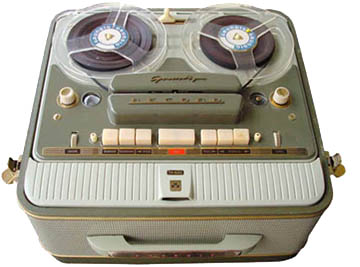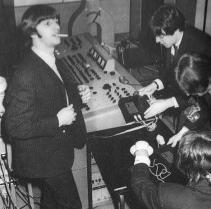![]()
D
 |
 |
|
|
Dante:
So far during your stay here we’ve
restored 32 of your tapes.
Approximately how many tapes of Hobart Pub
Bands do you have?
S: My ‘guesstimation’ is some 200 hours live pub music,
radio program promos, plus short skits, comedies, sound effects for
theatre plays, interviews from my home studio and radio programs.
Dante:
How did you get into the recording
game?
S: I think there must be a stray gene for it and I must have copped a double dose of it. In primary school one of my mates’ father owned a radio station (WPAB in Ponce, Puerto Rico), and we spend hours there. I learned how to cut sound on wire recorders and the ‘new fangled’ tape recorders, as well as the cutting of production discs.
My
older sister had an American music program on another station in my
pre-teens, and it gave me the opportunity to experience the broadcasting
side. I realized I did not want an occupation in commercial radio, but liked
the opportunities of the media. The bug was still biting hard.
My first paycheck from my first teen-age summer job bought my first tape recorder: a German Grundig 7” reel-to-reel. I got into creating what the parents called ‘noise’ by cutting and re-assembling bits of tapes to create ‘sounds-scapes’. There was little opportunity for live recording with high school and uni life-style raging. It was the '60s, and I remember little of that rush! Live recording was almost unheard of except for maybe jazz.
I did have my on-air program and the first ‘Rock & Roll and Rhythm & Blues’ Radio Program on WTUL, a closed-circuit radio station for Tulane University in New Orleans. I used the double term because I hit both Afro-American and 'white’ studios around New Orleans for material. Unusual at that time, as the two styles were still kept apart in the deep south. Being a limited broadcast range station I got away with it. For me it doubled the amount of studios I could visit. (That could be the topic of a book, some of those artists were right off the planet). ‘Payola’ was rampant, and further convinced me I did not want a life in commercial broadcasting. Live recording was still rare in most music genres.
I
bought one of the first cassette recorders when they came out. The little
Phillips 'Norelco' (used early by The Beatles) still works, but really no good for high quality
recordings.
My
first paycheck in Tasmania bought me a three-head Sony with max speed of 7.5
IPS. Good for decent home use but never for anything professional. I
recorded for various community groups presentations, some individual slick
rip-off merchants, and many folk/blues friends with guitars and vocals at
home, but never a group at home nor in the ‘wilds’ of pubs where music was
starting to make a greater appearance outside cabarets. Recording was not
even considered save someone recording with a hand held cassette recorder.
I
still taped a ‘PA Radio Station’ at a Tasmanian school where students
created their own programs in a ‘Pastoral Care’ period which was played
over the school PA in the following week’s period for those classrooms who
elected to have it during that period. Out of 25+ students, one makes his
living as a TV personality on the northern NSW/Qld border, and another has
created many creative community radio programs and has published numerous
cassette sets of plays, as well as numerous songs of his own created using
the portastudio. Nothing in live music area.
Dante:
Could you tell us a bit about the
radio show you hosted on community FM and its connection to the live music
scene?
S: I asked for and got the midnight-to-dawn slot on the local
community radio station 7CAE-FM
from 02:00 to 06:00 Saturday night/Sunday
mornings: it was a ‘dead-air’ slot that the station management thought I was
loony for taking: ‘There are no listeners.’, ‘Everybody is asleep.’ I
knew better. I was a rager in those days. There was live music EVERYWHERE,
and most venues closed at 01:00. I had been to numerous parties after
closing. Eaten snacks over coffee after closing. Arrested for D.W.I. after
closing. Sat at home or lounged in bed listening to tapes and records after
closing. The ABC signed off at midnight, and the commercial stations kept
yelling at you with their narrow selection of oft repeated music and ads all night
long, same as daytime.
I’d listen to music at the live music venues, then
shoot off to the program. There was an audience out there, and considering
the selection available, the program became widely listened to by many
varied people. Because I ‘pushed’ local music, I started receiving ‘demo
tapes’ from groups and individuals, and you were one of the
contributors by producing program promos. How I wished I could pull off a
‘live broadcast’ as the old Double-J
used to do in Sydney. We were too poor for all that was needed.
Dante:
What sort of equipment did you
use?
S: Opportunity came from the
availability of what is considered one of the best portable cassette decks on
the market at the time. I bought a
Nakamichi 550 and a set of three Nakamichi microphones. This deck had
sufficient gain in the earphone outlet that eliminated the need of carrying
an amplifier so I could hear what I was recording. I was recording in the
same room as the band, the audience and the mixing panel. I could now hear
what was coming into this deck, and it started. I was able to record a
decent sound!
‘Almost live to air’ is what I called it. I’d record a band, pack up and
go to the studio and that night play back what had happened earlier that
evening. It allowed musos to hear what they sounded like to their audiences and
what each other sounded like. The live music ragers listening to the music
they just had finished paying for again: while driving home, watching
submarine races, waiting for the sun atop Mt Wellington, or at parties.
Matric parties joined in and sent cheerios to each other. People liked it:
it was local, it was our music, it was involvement, it was fun!
Dante:
What sort of set-up did you use?
S: One of the difficulties with live recording is getting
away from the sources of the sound so you can hear what is actually going
through the equipment, and not into your ears. Notice that studios have a
massive amount of insulation around the control room to accomplish this,
especially for the lower sounds like the bass drum and the bass guitar,
which travel easily through materials.
With live recording the best setup is to go to another room to record, and
run a long multiple-line cable to all your microphones where the band is
playing. I could not afford the cable, nor all the microphones, nor all the
patches to plug into band equipment, nor a decent mixer to mix all these
inputs on my side of the mixer to feed into the tape recorder. Further, an
amplifier and speakers are needed to give the volume to hear what the
equipment receives. At that time I was just a relief teacher on a fairly low
income, and didn’t have the transport to carry all this expensive equipment.
I tried one of my conventional reel-to-reel decks
once, but the earphone outlet had no volume, so I could hear the sounds
through the cans (earphones), which were not acoustically transparent,
giving me no control over what was being
recorded. I could not afford another amp to just feed the earphones, and I
wanted to travel light to rush to the show afterwards. Reel-to-reel machines
were heavy and bulky, to boot.
The Nakamichi 550 gave me everything I wanted at a reasonable price: at
a tenth the price of what I wanted, but workable. The headphone amplifier had
enough guts in it to drown out the external noise; it did the trick, but I
always had deadened ears for about a day after recording. One case for
cables, mics, headphones, and other gear plus the Naka: portable.
S: I would take a live feed from the front-of-house mixing
desk as one channel into the recorder, and the other channel took its feed
from a strategically placed ambience mic gaffer-taped to the ceiling above
the band (avoiding the front of the bins that gave the audience their
sound). Neither proved easy, and required a bit of Wiley the coyote’s box of
tricks
Most sound engineers are more protective of anything you stick into their desks
than of their girlfriends. I built a gadget that gave me a sturdy 600
ohm:600 ohm isolation with a radio station transformer that had a 600 volt
breakdown for the protection of my gear. But I would ‘sell’ it as protection
of their desk. They were afraid that I would change the characteristics of
their desk, and at times I was unplugged because they had problems on their
side of things and thought it was my fault, only to find out it was not.
Most groups allowed me easier access the second time around. I used to make
the comparison to virgins.
The placement of the ambience mic was the most nebulous task and one of the
most important as properly done it could capture what I liked about live
music: that spontaneous interchange between an audience and the band
members. Too far from the group gave a tunnel effect with a horrible echo,
too close you had no audience, and it had to have a neutral position that
captured most of the members of the group and their instruments in a
delicate balance.
Experience with the venue helped over time. Bands usually followed a
standard configuration, usually, which made some things easier. Venue
repairs or any other structural changes could stuff the acoustics and I had
to start again. Also, publicans got upset over ‘X’ of missing ceiling paint
where I gaffered my mic. Years of experience with mic use helped this
placement, usually.
Before I ever placed the mic for the first time, I prayed to a number of
deities from different religions, read a chapter out of the Bible, and cast
an I Ching or three to finalize my decision on mic placement. Lightning
bolts never hit me, so I guess I was on the right track.
I
am happy to say that I was fairly successful at recording bands.
Dante:
How would you describe the live
music scene in those days compared to today?
S: Raging prior to drinking restrictions. Just in the
Hobart CBD where I operated from there were over a dozen venues with live
music, and that’s excluding the regular jazz concerts, the regular folk
get-togethers, and a massive Country & Western scene that blew me away
every time I visited one of their live venues. I think a lot of pubs made a
lot of money off the live music scene, and musos were for the most part
making some money, covering costs. I understand that in Melbourne musos were
out of pocket for providing live music, and a number of Melbourne groups
would come down to Tasmania for a spin and to replenish their coffers.
Dante:
Outlets apart from radio station?
S: Copies to band members / radio shows etc. Made radio show 50% live / Australian music. Also environmentalists.
|
Dante and 'S' Ken Stokes July 2003 |
Recorded on Nakamichi 550, Digitized and Mastered on Scope PCI |
|
| "Hell Is For Children" The Shifters 1982 |